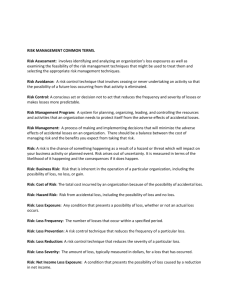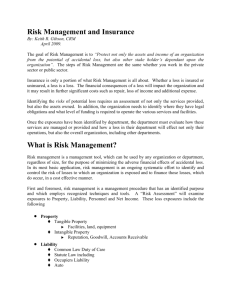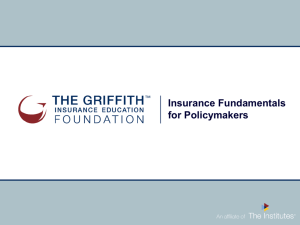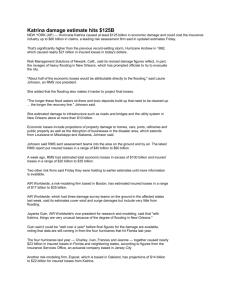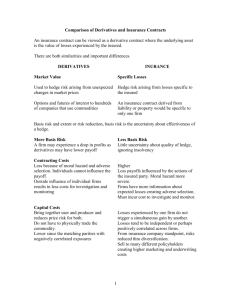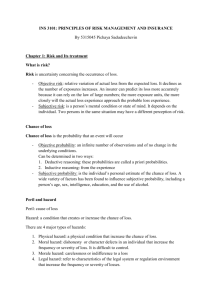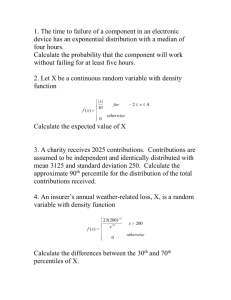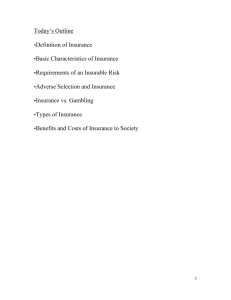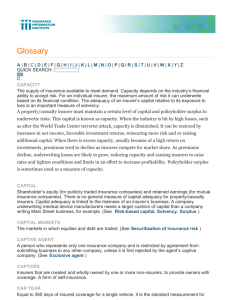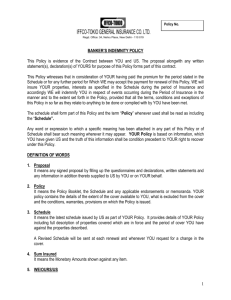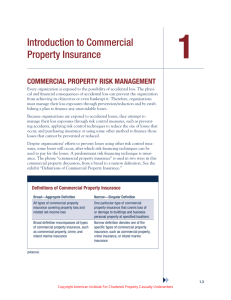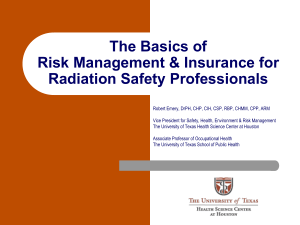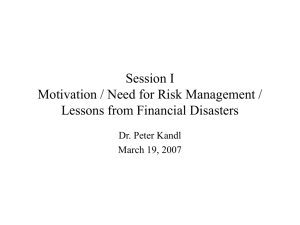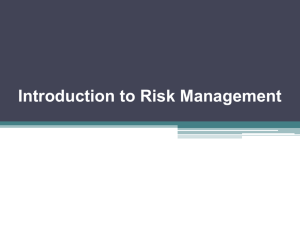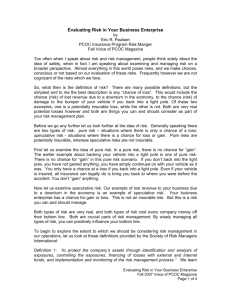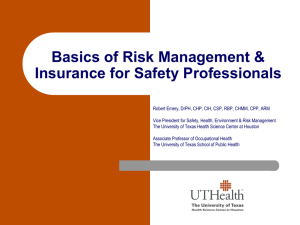CPCU500-TEST-2012
advertisement
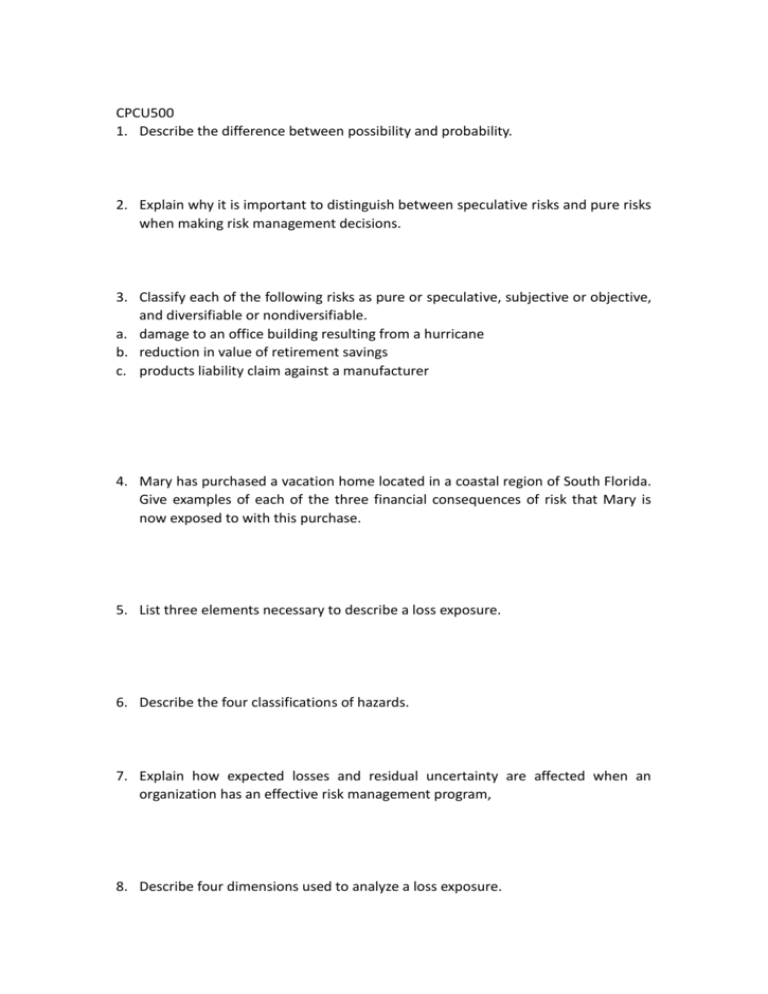
CPCU500 1. Describe the difference between possibility and probability. 2. Explain why it is important to distinguish between speculative risks and pure risks when making risk management decisions. 3. Classify each of the following risks as pure or speculative, subjective or objective, and diversifiable or nondiversifiable. a. damage to an office building resulting from a hurricane b. reduction in value of retirement savings c. products liability claim against a manufacturer 4. Mary has purchased a vacation home located in a coastal region of South Florida. Give examples of each of the three financial consequences of risk that Mary is now exposed to with this purchase. 5. List three elements necessary to describe a loss exposure. 6. Describe the four classifications of hazards. 7. Explain how expected losses and residual uncertainty are affected when an organization has an effective risk management program, 8. Describe four dimensions used to analyze a loss exposure. 9. Describe advantages and disadvantages of using questionnaires in assessing loss exposures. 10. Describe how complete data can aid a risk management professional in loss exposure assessment. 11. Identify two factors in past loss data that must be consistent to avoid underestimating or overestimating loss projections. 12. The risk management professional of ABC Manufacturing has the following data for losses that have occurred during 2009: Data Loss Amount Cause 1/6/09 Customer slip and fall $500.00 3/17/09 Damage to sales rep auto $3,500.00 3/17/09 Sales rep injury in auto accident $800.00 5/21/09 Assembly line worker back injury $7,000.00 8/11/09 Office worker back injury $500.00 a. If the risk management professional for ABC Manufacturing were trying to analyze employee injuries for workers compensation purposes, what data are relevant? b. Are the data provided complete? c. Are the data consistent? d. Organize the employee injury data into an array. 13. Identify two conditions in which probability analysis is effective for projecting losses. 14. List two requirements to construct an empirical probability distribution. 15. Describe coefficient of variation and how insurance and risk management professionals use it in asssessing loss exposures. 16. Assume that ABC Manufacturing’s total losses per year are normally disributed. The average (mean) of the firm’s losses is $500,000, and the standard deviation is $40,000. Assuming underlying conditions do not change, what is the probability that its losses next year will be between $460,000 and $540,000?What is the probability that its losses next year will be between $500,000 and $540,000? 17. list four dimensions used in the analysis of a loss exposure. 18. Describe two approaches a risk management professional may use when jointly analyzing the frequency and loss severity of a loss exposure. 19. Explain how proactive and reactive avoidance differ in reducing loss frequency of a loss exposure. 20. Describe the advantages of using cash flow analysis for the selection of risk control measures. 21. Which risk control techniques are commonly used to control liability loss exposures? 22. Describe loss prevention and loss reduction measures an organization might use to control work-related injury and illness. 23. Identify guidelines for design of an effective business continuity plan. 24. Describe internal and external methods an organization might use to increase cash liquidity. 25. Describe the four planned retention funding techniques available to an organization. 26. Identify the loss exposure characteristics that help an organization determine which loss exposures to retain and which to transfer. 27. Explain how the following individual- or organization-specific characteristics affect retention levels. a. risk tolerance b. financial condition c. core operations 28. Explain the difference between a self-insurance plan and a large deductible plan. 29. Describe three special types of group captives. 30. List the four areas in which traditional risk management differs from ERM. 31. Provide an example of an upside risk. 32. Possible treatments for risks to an organization’s strategy include some traditional risk management treatments, such as avoidance and transfer. What additional tratments are applied in ERM? 33. Explain how the ERM process can lead to increased management accountability. 34. Differentiate between Basel II and Solvency II. 35. Describe the likelihood of extreme outcomes when using a pooling arrangement. 36. Explain how an organization can achieve risk financing goals through the use of insurance. 37. Describe two common sources of liability risk faced by many commercial organizations. 38. The Pennsylvania state insurance commissioner is concerned that the state’s workers compensation insurance market is not competitive. Only a few insurers are selling workers compensation in Pennsylvania, and rates are high relative to many other comparable states.,Describe some of the considerations the insurance commissioner should take into account before recommending that the state become involved in providing workers compensation insurance to employuers in Pennsylvania. 39. List the distinguishing characteristics of an insurance policy. 40. Explain the distinction between a contract of indemnity and a valued policy. 41. List two general policy interpretation rules that are applied when an endorsement conflicts with the policy to which it is attached. 42. Identify loss exposures typically excluded from a policy because they are considered uninsurable. 43. In what two ways does an insurer benefit when property is insured to value? 44. Describe three common methods of determining ACV for property. 45. Explain how insurers reduce the potential moral hazard related to offering coverage on a replacement cost basis. 46. An insured with a CGL policy incurs a covered claim for $500,000 in damages. The policy has a $1 million each occurrence limit. Prior claims paid during the same policy period reduced the applicable aggregate limit to $100,000. Explain how the insurer’s payment is affected by these facts. 47. Describe two reasons for including deductibles in insurance policies. 48. The value of property damage liability losses is largely determined by the costs involved in replacing damaged or destroyed property of others and compensating them for the loss of use of that property. Identify three factors that affect the valuation of bodily injury liability losses. 49. The courts can affect the interpretation of insurance contracts. Identify two insurance – specific issues related to the interpretation of an insurance contract the courts may decide. 50. Courts apply legal doctrines and principles, external to the insurance contract, in interpreting insurance contracts and in applying them to specific cases. Explain each of the following legal doctrines. (a) Reasonable expectations doctrine (b) Substantial performance doctrine 51. Many commercial property policies have coinsurance clauses. (a) Explain the purpose of the coinsurance clause. (b) A property insurance policy is not voided if the insured fails to meet the policy’s coinsurance requirement. Explain what takes place if the insured suffers an insured loss, but has not met the coinsurance requirement. 52. In contrast to preprinted policies, some insurance policies are custom designed through negotiation between the insurer and the insured. (a) Identify the name for this type of policy (b) Explain why this type of policy would be used 53. Although an insurance company fundamentally resembles a formal pooling mechanism, they are distinct in two important ways. Describe these two ways in which insurers differ from a formal pooling arrangement. 54. Convenience Store Chain has decided to forego the purchase of property insurance and retain its property losses. Explain each of the following methods of funding retained property losses, and state one advantage of each. (a) Post – funding (b) Pre – funding 55. Who typically performs the risk management function for each of the following? (a) A family (b) A large corporation 56. Statisticians use various sophisticated measures to quantify the credibility of data used by risk managers. (a) Define the law of large numbers (b) Explain how the law of large numbers is related to the credibility of loss data 57. Peter has recently purchased a popular model of a thirty – foot pleasure boat that he plans to use in the waters surrounding his coastal Florida community. He wishes to purchase property insurance covering the boat for the coming year. With reference to the six ideal characteristics of commercially insurable loss exposure, answer the following questions. (a ) Identify two such characteristics that this exposure possesses. (b) Identify one characteristic that this exposure possesses, other than one you identified in your answer to (a) above, that may not be commercially insurable by this standard. 58. Josh Bloom owns and operates a 120 – cow dairy farm in Wisconsin, and his brother Jeremy has a similar dairy farm in California. Each of the brothers expects to produce 2 million gallons of milk per year. Both brothers are concerned that disease, drought, or other factors could limit their milk production. They are also concerned that federal subsidies will reduce the level of milk prices. In an attempt to reduce each brother’s risks, they agree that if either brother’s farm fails to produce at least 2 million gallons of milk in any given year, the other brother will make up half the loss. (a) Explain why this loss – sharing arrangement would reduce risks for both brothers. (b) In what way are the brothers’ risks(1) correlated, and (2) uncorrelated? 59. Explain how a manufacturer’s products recall exposure should be categorized in each of the following pairs, giving reasons to support your answer. (a) Subjective or objective (b) Financial or nonfinancial 60. Yolanda Downs has presented a claim to the Organic Insurance Company (OIC) for damage to her automobile. OIC assigned the claim to a claims representative. List three questions OIC ‘s claims representative must answer in analyzing the policy to determine whether Downs’s claim is covered.


